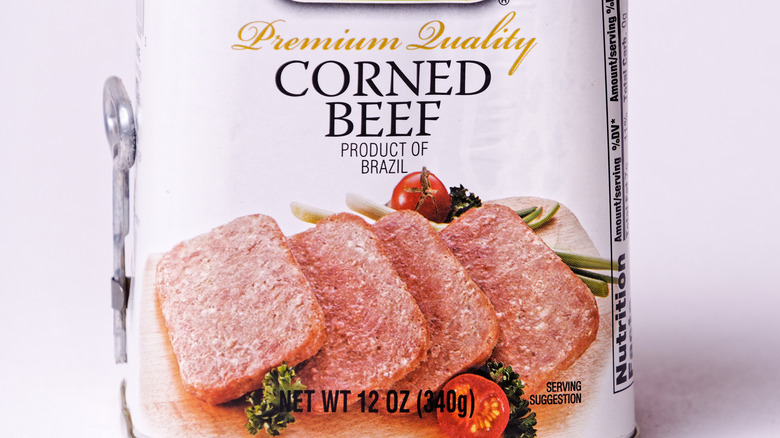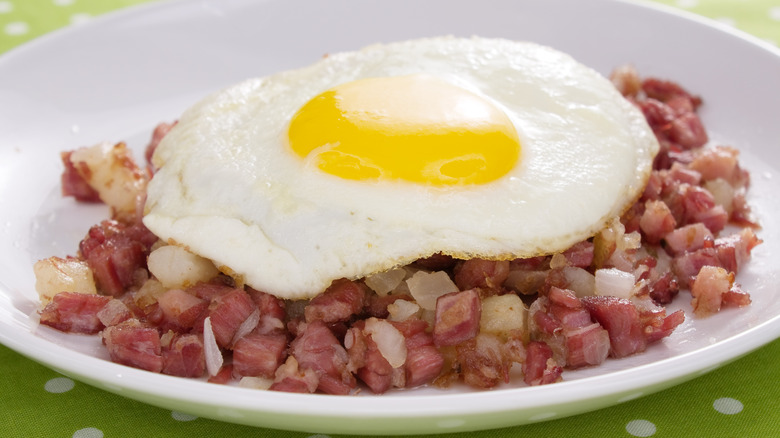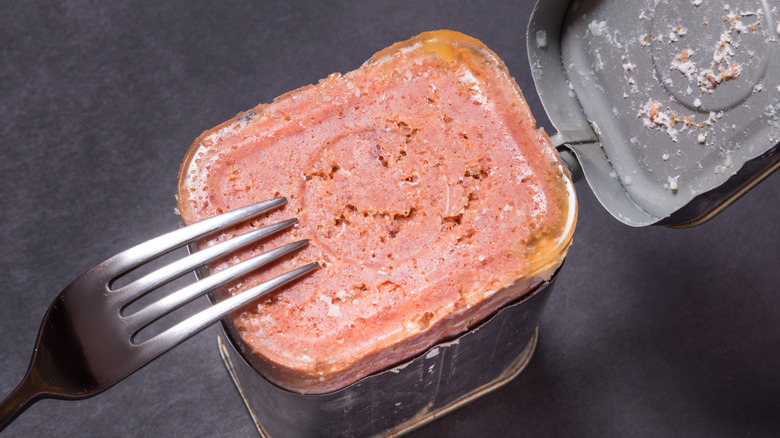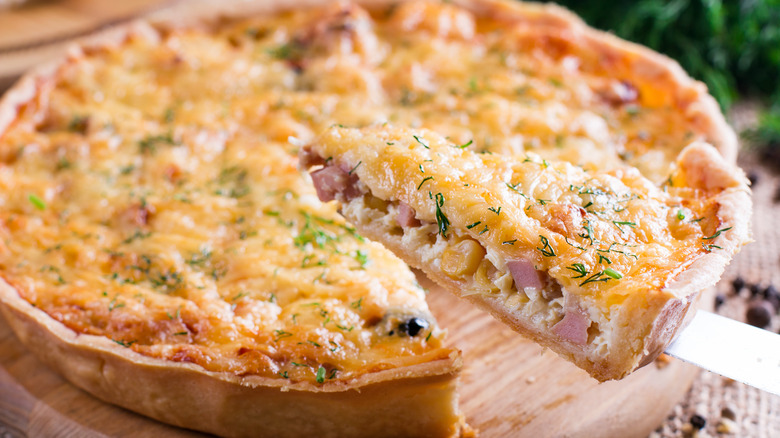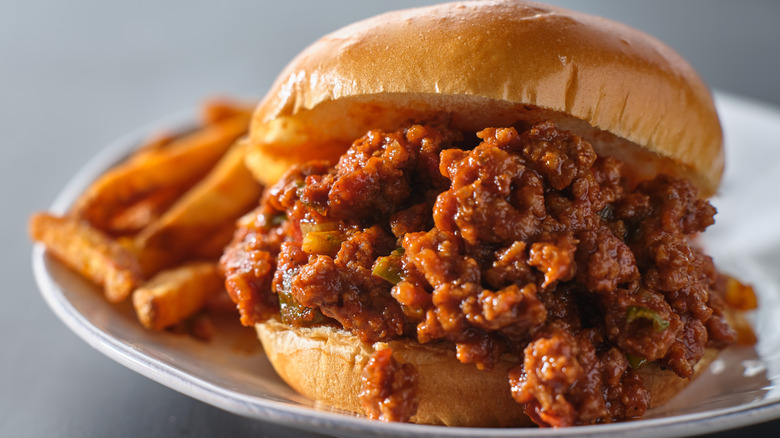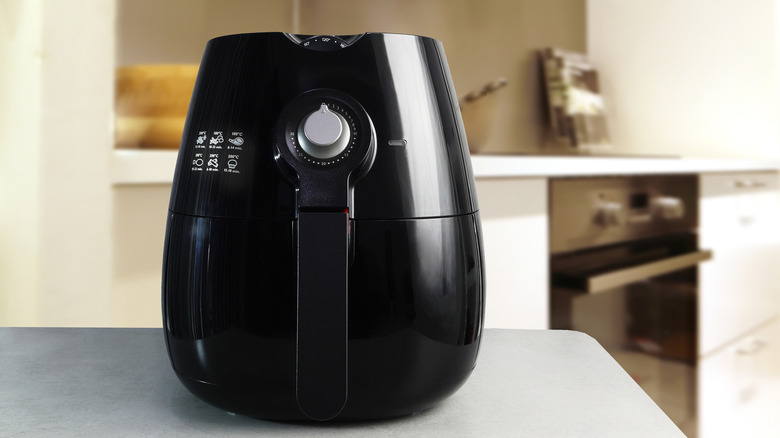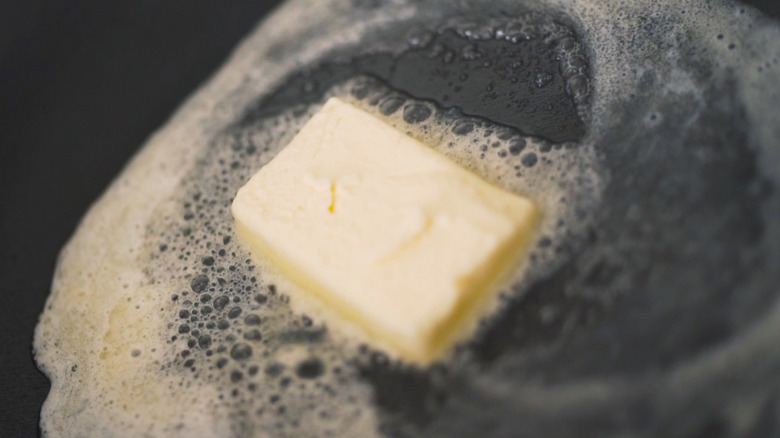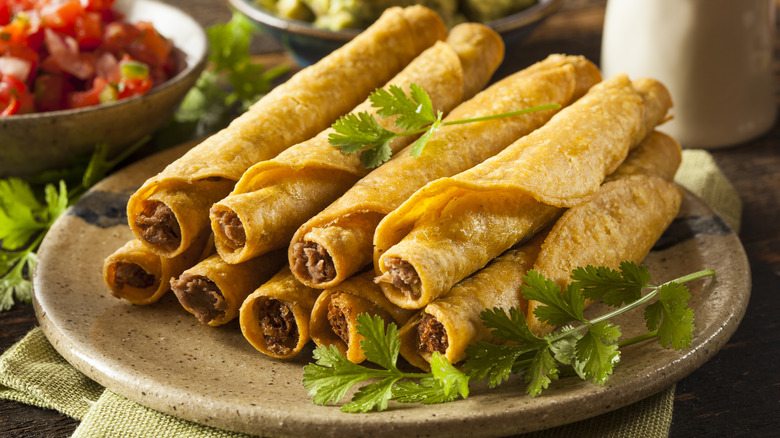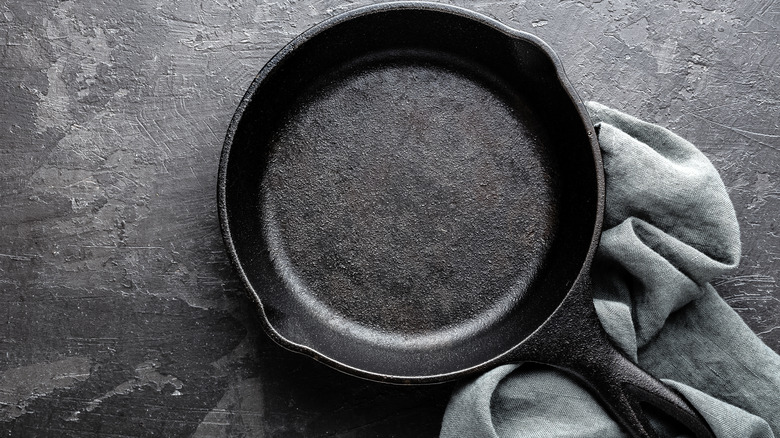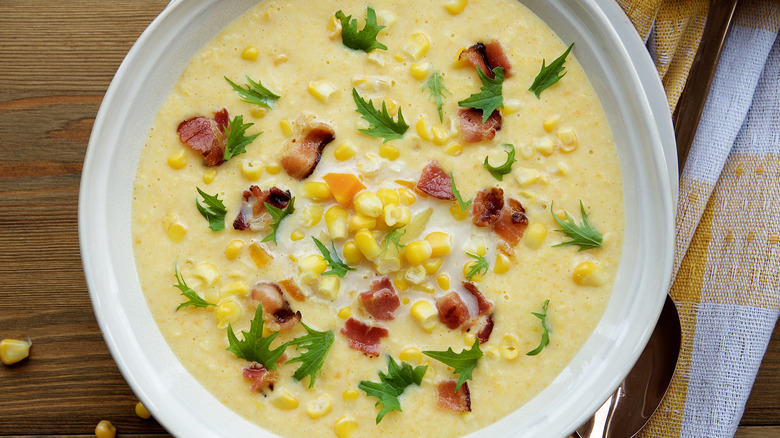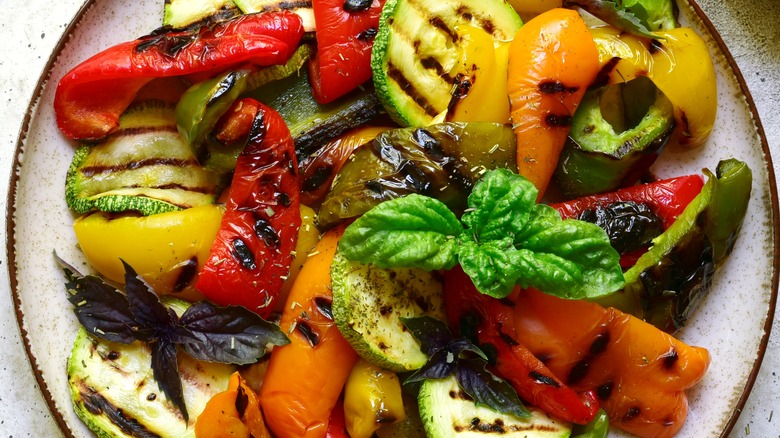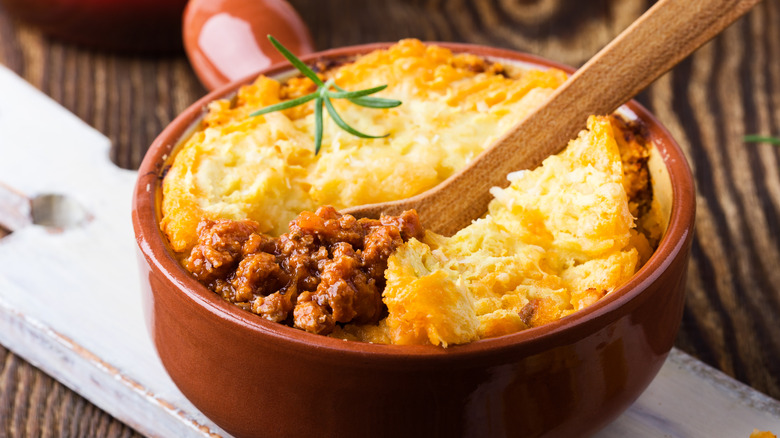The Best And Worst Ways To Eat Canned Corned Beef
You might be thinking that the only way to eat canned corned beef is when roughing it in the outdoors — or not eating it at all. If you haven't experienced it while camping, you've probably seen a can hidden in the back of a shelf somewhere — like Granny's pantry — or even in a college dorm room. where it probably served as a bookend or was meant to help sustain you after your meal points ran out.
Canned corned beef, if not fancy, is incredibly filling — at least it has that much going for it. But this canned meat is really not intended for those following a low-fat or low-sodium diet (via Healthline). That being said, there's a reason why most outdoor enthusiasts pack this tinned mystery beef in their gear — it's got everything a deep-woods hiking or camping enthusiast needs to make it through a long day and satisfies 28% of your daily recommended protein requirement.
Wherever you've seen it or however you've consumed it, chances are you've probably not strayed too far from the "dump can in pan and try to fry" methodology of cooking. By not allowing canned corned beef to reach its full gastronomical potential you're missing out on some really epic ways to transform it from ho-hum hash to a phenomenal feast. That's why we've compiled not only the worst ways to eat canned corned beef, but also some of the best new and improved tricks to spice up this classic canned cuisine.
Best: with an egg (or two)
If you think about it, a lot of good things come in pairs. Take, for example, the following dynamic food duos: cheese and crackers, shrimp and grits, peanut butter and jelly, milk and cookies, and of course, bacon and eggs. In this case, make it canned corned beef and eggs. This protein-packed breakfast meat is arguably best served with a fried egg. Even better, opt for corned beef hash with an egg on top.
The running yolk in a fried egg acts like a creamy sauce and helps cut the saltiness of the canned meat. If you want to get fancy, add a poached egg instead of a fried one for the same effect. You might be wondering if it's suitable to sub in a scrambled egg instead, and the answer is no. Why? For one thing, canned corned beef has a specific texture. It's either mushy and lifeless or, if cooked properly, can actually be crispy and delicious. A scrambled egg doesn't have much texture going for it. In fact, if your canned meat isn't crisped enough, scrambled eggs will lend just another mush factor to an already soft meal.
Worst: eating canned corned beef plain
Don't treat yourself so harshly if you haven't been eating as well as you'd like to be. If there's anything we've learned from the past few years, it's that we should celebrate every day and that self care is not an indulgence — it's a necessity. So you're eating molded meat from a can. So what? Use your creative genes and make something of it. Don't just be plain and mundane — one of the worst things you can do is leave your corned beef totally untouched. Transform your canned meal into something you truly want to eat. Let those fantastic, savory smells waft from your kitchen and turn heads, in a good way.
It doesn't even have to be anything major, either. You can sauté some garlic or onions, or even add in potatoes or fennel. Make it a meaty lumberjack-style meal and fry up some super crispy bacon. Even adding some simple herbs will really lift your canned corned beef to another level. May user roughly chopped flat leaf parsley, which will add a bit of earthiness to your meal. Thyme adds a nice minty, citrus flavor, while oregano will bring a nice little Italian twist to your dish. They can be dried or fresh herbs — just remember that dried herbs are more concentrated in flavor, so a little goes a long way. When in doubt, just add a touch of pepper, or even a bit of maple syrup to counterbalance the salt.
Best: you're transforming it for breakfast
Canned corned beef is considered to be a breakfast food by many. And this mighty meaty meal has tons of potential to be a transformative breakfast experience, because it's truly more versatile than you might think. Almost any savory morning meal can most likely benefit from adding or substituting the salty, fatty goodness of canned corned beef.
For example, if you're a lover of breakfast tacos or burritos, just fry up some canned corned beef and substitute it in place of the protein. If you can't start the day off without a nice hearty omelet, consider adding some canned beef, sautéed tomatoes, and feta or goat cheese to your next egg wrap. The acidity of the tomatoes and the funk from the fromage will help cut the salt profile. What about adding some canned corned beef to a frittata or quiche? Or if you're going to a brunch picnic, consider making some crescent rolls filled with canned corned beef, scrambled eggs, and gooey cheese (via Hormel). And if you really want to get fancy, sprinkle the tops of the dough with everything bagel seasoning before you bake them.
Worst: you're only eating it for breakfast
Don't go pigeonholing canned corned beef as being only suitable to eat at breakfast. It really is okay to eat this stuff for lunch and dinner, too. It's time to break the gelatinous meaty mold and make your own canned corned beef tradition. Go big, go bold, go away from the breakfast crowd.
Canned corned beef can be a great substitute for meals that require ground protein. Take, for example, the nostalgic childhood favorite, the Sloppy Joe – possibly the reason why paper the napkin really became a big thing (kidding). Canned corned beef can also be substituted in place of the pastrami or regular corned beef in a Reuben sandwich. Just make sure to crisp it up before you layer everything together. You can totally nosh down on it right out of the can, but it's just not the same as the fried up version.
Everyone loves a good meatball, and according to the food blog, Ready Set Eat, canned corned beef makes great little meaty morsels. The recipe is simple and only requires your canned mystery meat, ground beef, an egg, and breadcrumbs. If you're feeling lazy but need some party food, whip up a dip by mixing a can with sour cream, mayonnaise, parsley, onion, and dill (via Taste of Home).
Best: using an air fryer
Long gone are the days of being forced to eat greasy canned corned beef for your morning meal in your attempt to crisp it up. Enter the new, improved corned beef cooking method of the future: the air fryer. If it sounds too good to be true, it's not. While it's always fun to whip out your cast iron skillet and cook up a breakfast full of camping nostalgia, sometimes the added ingredients for frying — and the mess that comes afterward — aren't necessarily something you want to deal with.
On its own, canned corned beef is a great source of protein with 56 grams, according to Calorie King. That being said, canned corned beef isn't exactly the optimal choice for a low-fat or low-sodium chow down sesh. According to the CDC, Americans should consume less than 2,300 milligrams of sodium per day. One serving, which is 1 cup of Libby's canned corned beef, satisfies over half of that daily recommendation (nutritional data varies from brand to brand). When crisping the meaty mixture, the use of extra oils or fats also comes into play. So by utilizing your futuristic air fryer, you're eliminating any need for extra fatty additives, and knocking off any potential extra calories, all while creating deliciously crisp corned beef.
Worst: cooking canned corned beef in butter
Butter is delicious, but it does have its time, place, and purpose. Butter is great when used for browning or sautéing, but it might not be the best fat for getting a good crisp. Masterclass notes that butter has an incredibly low smoke point, or burning point, which means that your chances of scorching your beloved breakfast are much greater. Should you choose to use this particular ingredient for crisping, you'll need to make sure to keep your eye on the pan and the flame at all times. It's no fun having your fire alarm sound off first thing in the morning. Especially if you were planning on making a surprise breakfast for other people living in your abode — that would be a whole different kind of surprise.
Using butter to fry your canned corned beef is also a way to add unnecessary fats and calories to your diet. And it's really not needed. Canned corned beef already contains fat that will cook down and help with the cooking process. But if you really feel the need to add something, opt for refined oils, or those with a high smoke point, like canola or vegetable oil. Still stuck on the buttery flavor? Then check out clarified butter or ghee, which also works.
Best: turning it into party bites
If you've recently been invited to a party, picnic, or other social gathering, it would only be natural to bring some tiny finger foods to show off your cooking prowess, and appreciation, right? That being said, canned corned beef is probably not high on your list of go-to items to feed the party masses. But that doesn't mean that it couldn't be and shouldn't be. It's a relatively cheap ingredient to buy in bulk and it can save you time and money if you can think outside the box.
Remember — imagination is key. Which is why hiding canned corned beef inside a fried wonton wrapper is such a great and sneaky way to transform it. Everyone loves egg rolls, so why wouldn't a corned beef and cabbage egg roll work? In today's foodie world, it really is all about creative food fusion. You can also try taking a spin on another finger food classic and use canned corned beef, along with some cheese and taco seasoning, as a filling for some homemade taquitos. You're sure to be the life of the party.
Worst: you're not using the right pan
Perhaps one of the reasons why you don't like cooking canned corned beef is because it inevitably ends up clinging to the pan so tightly that nothing can break its eternal embrace. It's no fun once you've got a blackened, burnt mess to deal with. Lucky for you, this issue could be as simple as switching up the pan that you're using. The best way to properly fry up your canned corned beef — and pretty much any other food that you want to get perfectly crisp — is by cooking it in a cast iron skillet. The durable pan can stand up to the super high temperatures you need for rendering fat, frying meats, and more (via Bon Appétit).
If you don't have a cast iron skillet, you can opt for a Teflon, or nonstick, pan to ensure an easy clean up. But steer clear of stainless steel cookware, as it's very easy for your corned beef to get stuck to the bottom while cooking (via Science of Cooking). And you know what that means? A recipe for disaster.
Best: adding it to soups and stews
Sometimes making meat-based soups and stews can take more than a few extra steps, and that can end up taking more than a handful of extra minutes, which you might not necessarily have. Using canned corned beef to replace not only the protein element, but also any extra salt, is a great way to use up that magical mystery beef, and cut your cooking time down. Think of it like a foodie win-win situation.
Carne Bif, Puerto Rican stewed corned beef, calls for using the canned version specifically (via Delish D'Lites). At its most basic, no frills level, this homestyle stew incorporates the canned meat, potatoes, sweet corn, tomato sauce, sofrito, all-purpose adobo seasoning, as well as sazón seasoning. This is an incredibly simple dish to make and takes less than 20 minutes. Serve it with avocados and white rice, or get really traditional and fry up some sweet plantains.
If you happen to have a carrot or two, a few ribs of celery, an onion, and some pearl barley — you can always substitute another grain or rice-like pasta, too — try making some vegetable beef and barley soup, substituting with canned corned beef. Or maybe crisp up some corned beef and add it to a corn or potato chowder. The creaminess will dull the sodium and the crunch will bring some nice texture to your bowl of comfort food.
Worst: you're skimping on the veggies
Science states that there is no downside to eating a nice rainbow assortment of fruits and vegetables, and while produce of pretty much all colors can be touted as having anti-inflammatory properties, each individual variety benefits a different bodily component (via Healthline). Another great thing about fruits and veggies is that you can't really have too many of them. The more, the merrier.
When it comes to canned corned beef, the added vegetables will help tone down the sodium level, and give your mushy meat some much needed textural and flavor variety. If you've been eating plain canned corned beef, it's time to liven it up with some color. If you're a little weary of creating your own flavor combinations, just start small and add some cubed potato, onion, and an herb like basil or rosemary. Then try roasting some brussel sprouts along with your crispy meat. Or make a mélange of roasted vegetables and serve them alongside your protein sauté. Don't forget to marvel at all the healthy colors gracing your plate. It could be so beautiful that you don't want to scarf it down — but it's okay to destroy your own masterpiece.
Best: exploring different cultures
Although canned corned beef is a 100% American foodie creation (per The Food Timeline), that hasn't stopped it from circumnavigating the globe and unsuspectingly plopping itself down at the tables of different international cuisines. In Jamaica, canned corned beef is called bully beef (via Eat With Your Eyes LLC). The canned corned beef is cooked with bell peppers, onions, garlic, thyme, and Scotch bonnet peppers (which you'll also find in the Jamaican classic, jerk chicken), and served alongside starchy foods like boiled green bananas or rice.
The Chamorro — the indigenous peoples of Guam and the Mariana Islands, per Britannica — are particularly fond of corned beef with cabbage and onions. This classic comfort dish incorporates canned corned beef, sautéed onion, thinly sliced green cabbage, and sometimes green beans or eggplant (via Stars & Stripes Guam).
Canned corned beef also lends itself quite well to the humble and filling casserole-type dish, cottage pie. Masterclass notes that cottage pie is pretty much the same as its sibling, shepherd's pie, except that the latter uses ground lamb and not ground beef. In addition to your protein of choice — in this case, that would be your beloved canned corned beef — this traditional, homey British pub food contains garlic, onions, and carrots, as well as tomato paste, Worcestershire sauce, and a few other kitchen staples. And of course it all gets topped with fluffy mashed potatoes.
